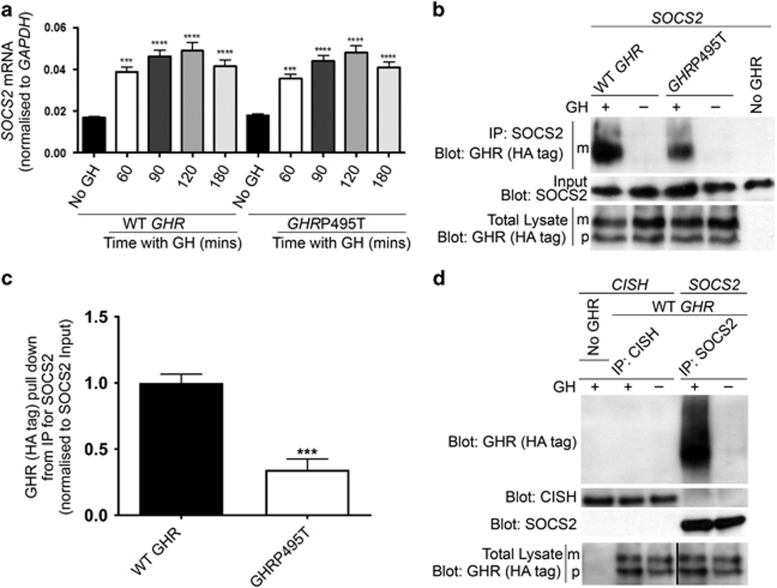Figure 4.
GHRP495T impairs SOCS2 binding to GHR. (a) No difference in SOCS2 transcript induction between WT GHR and GHRP495T. HEK293 cells transduced with WT GHR and GHRP495T were maintained in serum-starved media with sustained GH (2.3 nM) then RNA was extracted at indicated time points. SOCS2 levels were determined by real-time PCR and normalised to GAPDH reference gene. Data presented as mean±s.e.m. analysed by one-way ANOVA (****P<0.0001, ***P<0.001). Representative of three independent experiments confirmed in three separate lines generated by independent transductions. (b) HEK293 cells stably expressing WT GHR or GHRP495T, and parental cells transfected with SOCS2 expression plasmid for 24 h and serum-starved overnight before 2.3 nM GH (+) or vehicle (−) stimulation for 15 min. Lysates were harvested and co-IP with SOCS2 antibody as described in Materials and methods. Protein complex from the immunoprecipitates were immunoblotted (IB) using anti-HA antibody for GHR (mature (m) receptor and precursor (p) receptor) and anti-SOCS2 (input). As control, parental cell line with no transduced GHR was used and a small volume of total cell lysates used for co-IP was probed for GHR levels (HA-tag) to indicate GHR levels. (c) Graph represents the signal intensity of total GHR (HA-tag) pull down in GHRP495T relative to WT GHR relative to SOCS2 input, corrected for endogenous GHR expression. Data presented as mean±s.e.m. analysed by Student’s t-test (***P<0.001) and representative of nine independent experiments confirmed in three independently transduced cell lines. (d) CISH protein does not interact directly with GHR as compared with SOCS2. HEK293 cells stably expressing WT GHR co-transfected with CISH or SOCS2 expression plasmids for 24 h and serum-starved overnight before 2.3 nM GH (+) or vehicle (-) stimulation for 15 min. Lysates were harvested and co-IP with SOCS2 and CISH antibodies simultaneously. Protein complex from the immunoprecipitates was immunoblotted using anti-HA antibody (for GHR) and anti-SOCS2 and anti-CISH antibodies. As a control, parental cell line with no transduced GHR, but transfected with CISH was used and a small volume of total cell lysates used for co-IP was probed for GHR levels (HA-tag) to indicate endogenous GHR levels (see Supplementary Figure 2).

